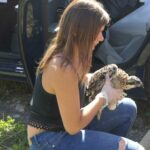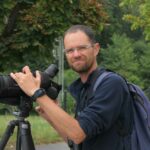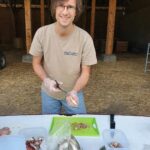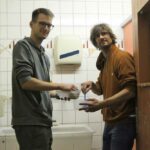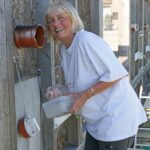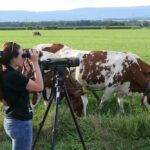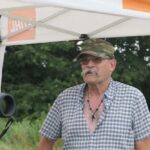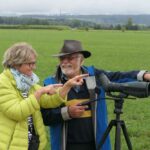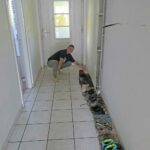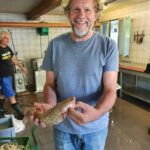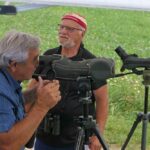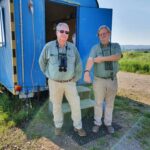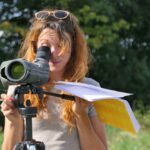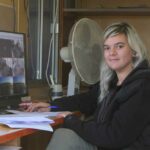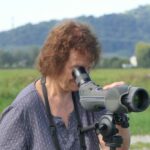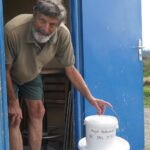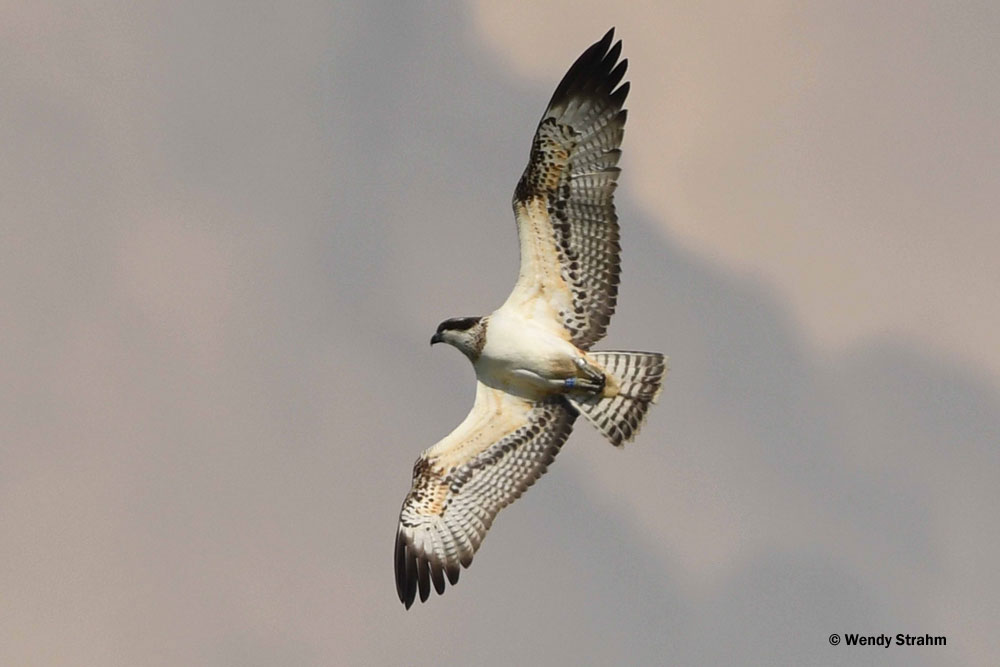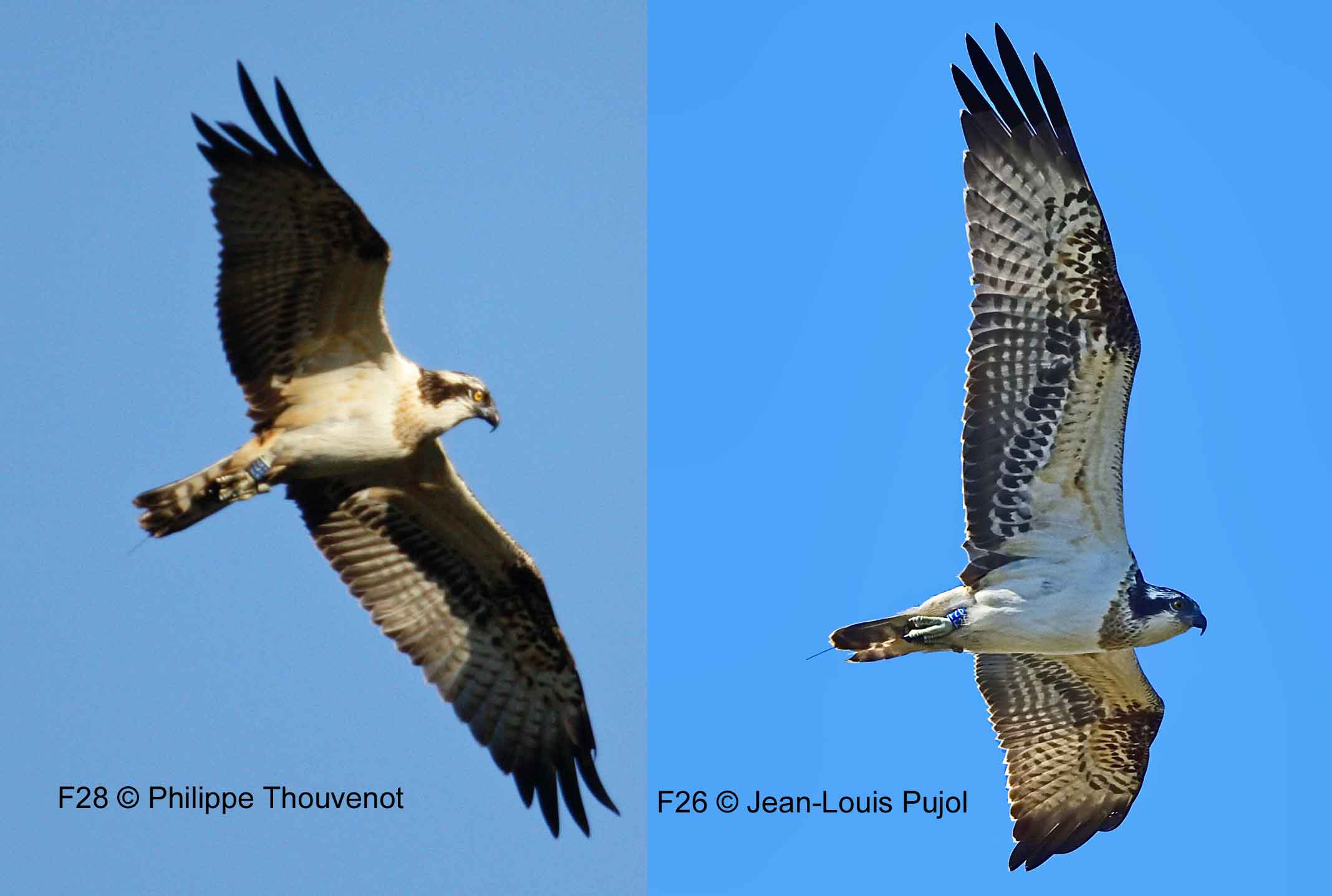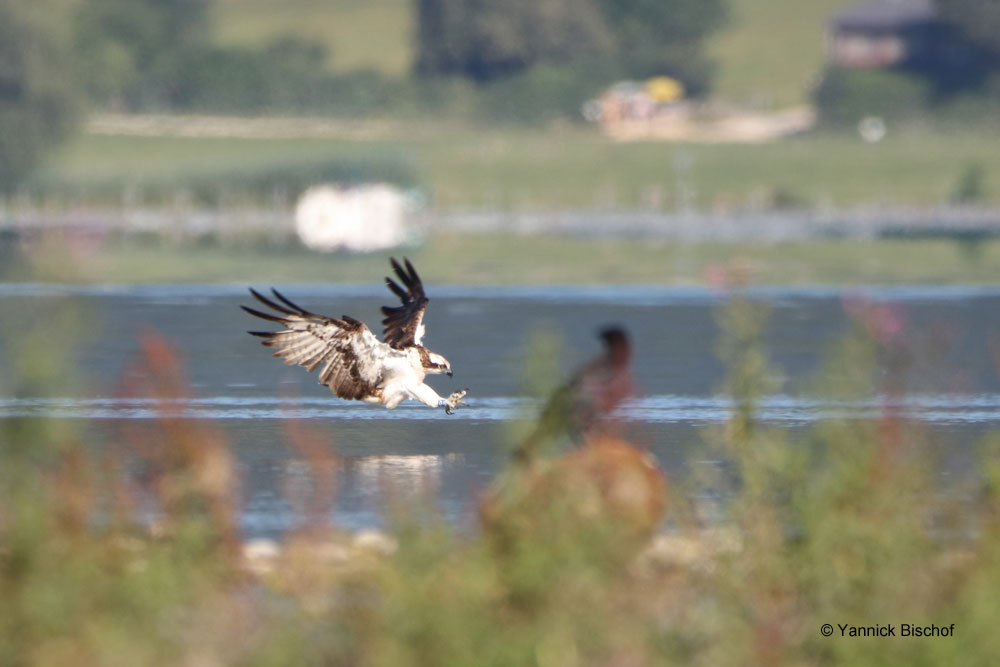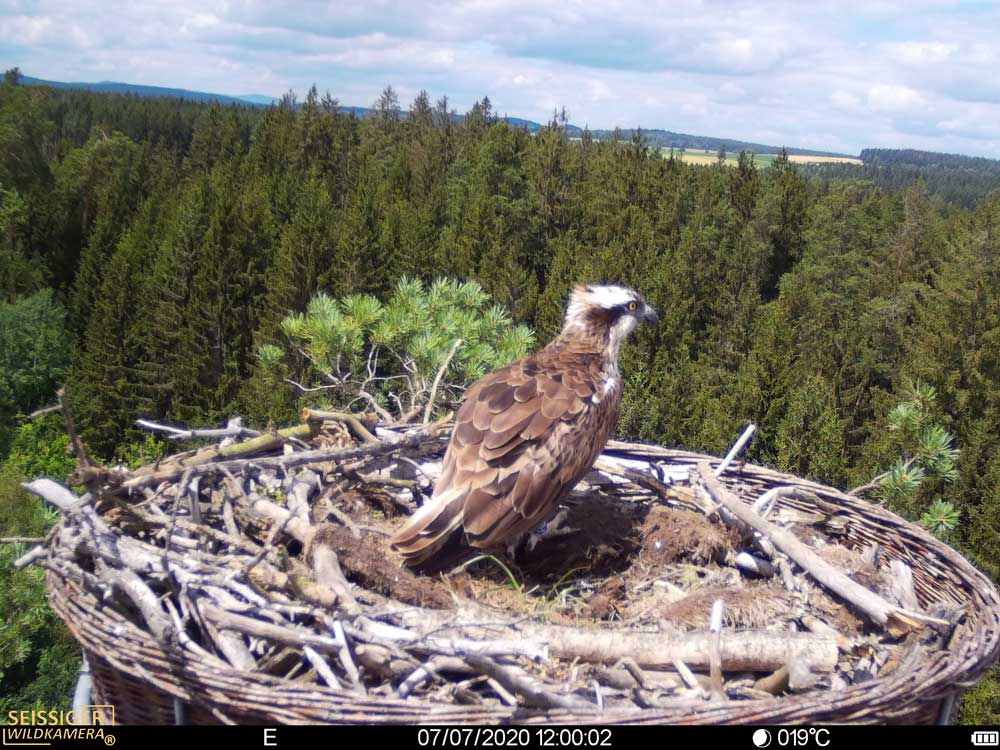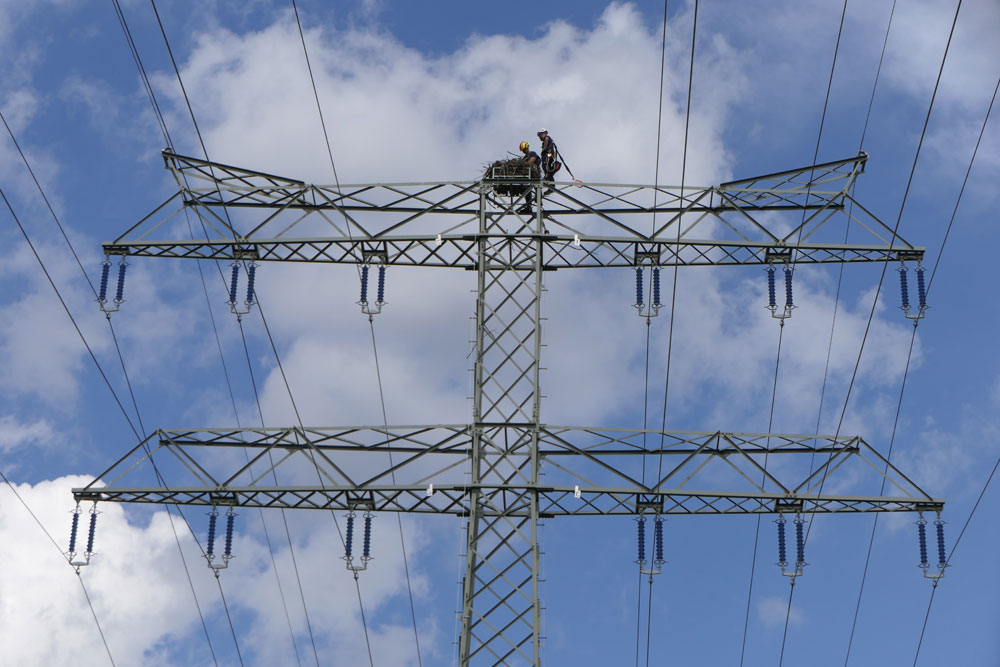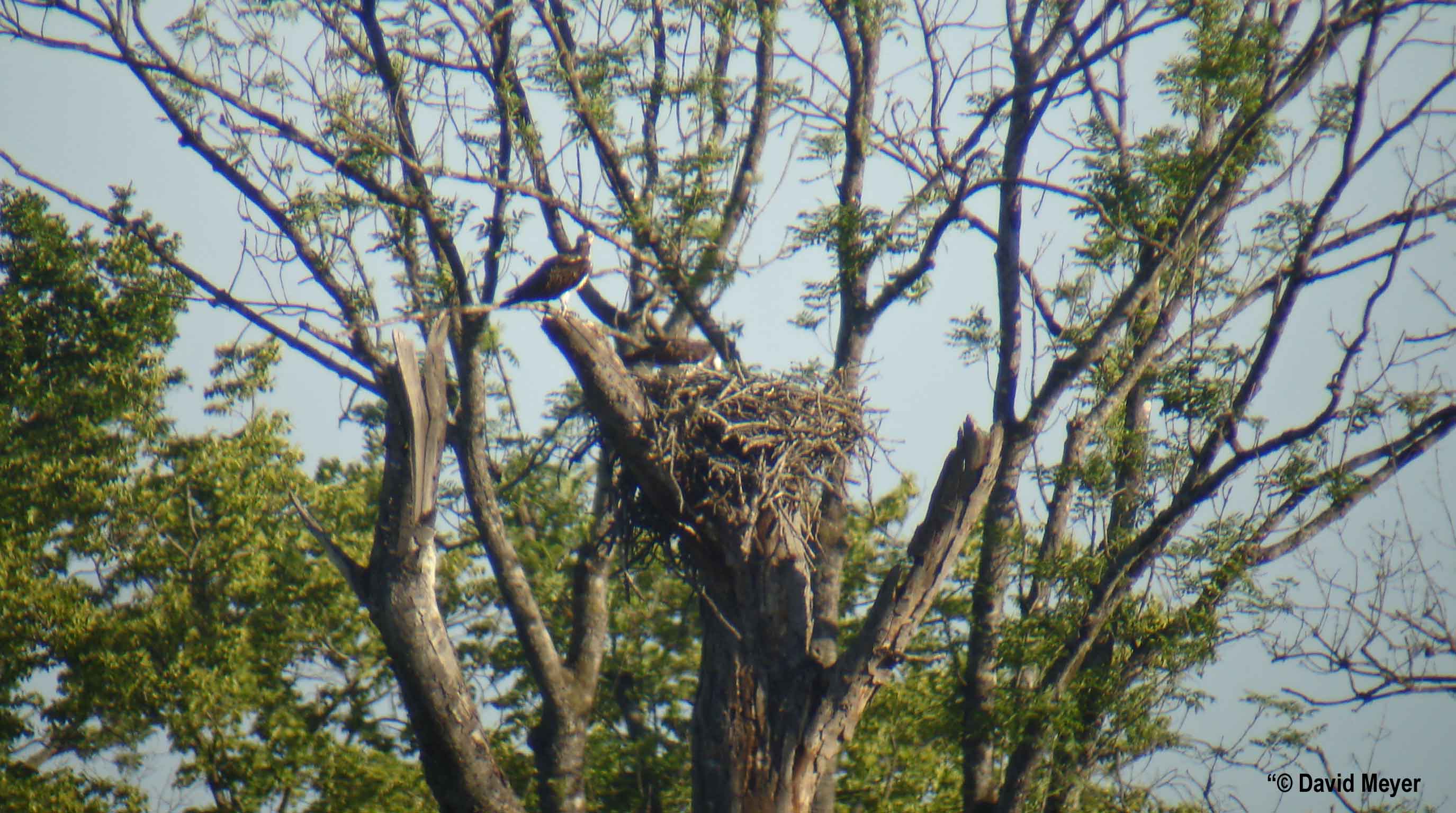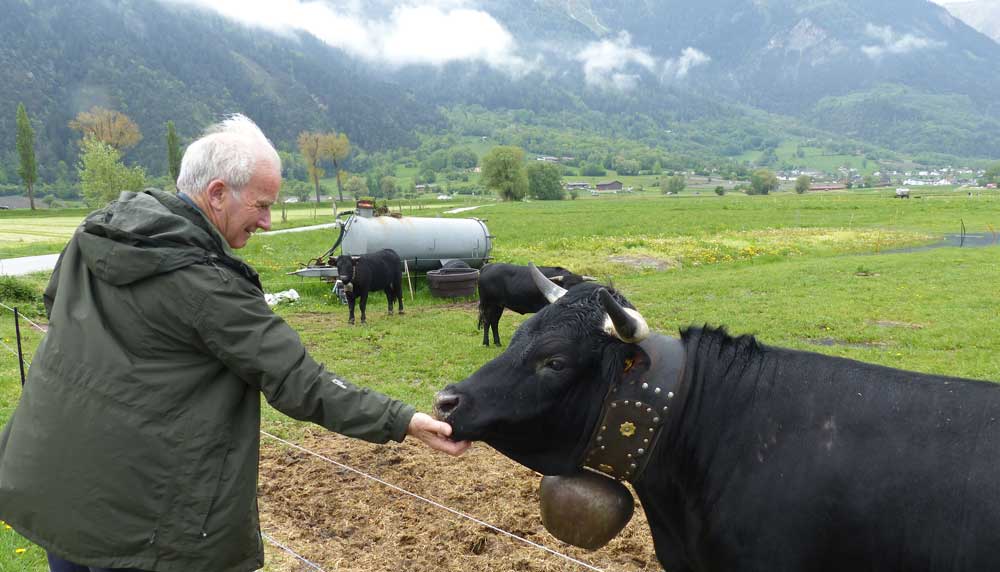We had another good season in 2020, with all 12 chicks released migrating, plus we had two birds, Taurus PS7 (from 2017) and Arthur F12 (from 2018) returning to Switzerland. This was thanks to all the hard work of many people both this year and in previous ones. Special thanks go to the volunteers who spent at least two weeks of their precious time helping in the field at Bellechasse: Océane Cordoliani, Christophe Chaigne, Niels Friedrich, Martine Guex-Meier, Alba Hendier, Sven Henrioux, Johnny Kursner, Florian Meier, Catherine Robert, Jean-Luc Simon and Marièle Zufferey. They all worked enthusiastically with the Osprey wardens Cyrielle Boudon and Marine Brunel, long-serving volunteer Denis Landenbergue, and project coordinator Wendy Strahm. Not forgetting Adrian Aebischer, Michel Beaud, Emile Curty, Pascal Rapin, Christine Rast, Pascal Schöpfer and many other colleagues and supporters who also helped the project in one way or another in 2020 (all listed in our report to be published in the March 2021 issue of Nos Oiseaux). Our warm thanks to all!
Category Archives: News
Au revoir Amphore
The winner of the “last to leave” contest this year is Amphore (F30), a young female from Germany named after the vase-like design on the back of her head. After days of observing her just lying about and only moving when feeding, we realised that (very fittingly) “Amphore” is an anagram for “Amorphe” (French for “passive”)! However, her seemingly “laziness” was just because she was the youngest of the German birds. She soon became more active, growing up to become a beautiful strong female (see photo, taken the day before she migrated). On September 17, a bright day with a strong north-easterly “bise” wind, she circled up high towards the Lake of Neuchâtel and disappeared over the horizon, bringing to an end our 2020 season.
The first to migrate had been Zeppelin (F26) on August 15 and Olympe (F28) on the 25th. Then six more left in the first four days of September: Méandre (F25), Volcan (F31), Tonnerre (F32), Jedi (F35), Tulipe (F36) and Gustave (F27), soon followed by Racine (F29) on September 7. And then there were three. Who seemed to bond and be in no hurry to leave, happily enjoying the Indian summer at Bellechasse. The two youngest Norwegians, Rugby (F33) and Silex (F34), finally migrated on September 15 and 16 respectively, with Amphore leaving the day after.
As for the two confirmed male returnees of this year, Arthur (F12, born in 2018) migrated on September 1 and Taurus (PS7, born in 2017) on September 4. In addition, David Meyer, who discovered Mouche (PR4, born in 2016) in Moselle and monitored her first breeding attempt, tells us that she and her mate spent the summer there and were last seen together on September 1.
So a globally positive season, even if despite our best efforts, we again did not succeed in releasing many more males than females this year. The reason why we hoped to reintroduce a larger proportion of males is because, being more philopatric, they traditionally return to the area where they fledged, which is much less often the case with females. While we still await confirmation from the DNA analysis later this autumn, it seems that this year we have released seven males and five females.
As the season draws to a close, once again a big thank you to the Osprey project team for their dedication and enthusiasm in taking great care of the birds, and ensuring their safe departure to destinations unknown.
Two out of two
Up to now, two of the 12 young Osprey reintroduced this year to Switzerland have migrated, and we have just had some wonderful news: both have been seen on a stop-over in France! We have only once before had one of our birds identified during its autumn migration in Europe: Georges F03, spotted in Spain in September 2018.
This summer, Zeppelin (F26) was our first bird to leave on August 15, a week before the earliest departure ever recorded before by the project (that of Tache (PS6) on 22 August 2017). We are happy to learn that he was seen fishing on August 27, in the company of three other Osprey, by Jean-Louis Pujol at Etang de Vaccares in the Camargue – just 3 km away from the home of Luc Hoffmann (a great Osprey fan and supporter of its reintroduction) at the Tour du Valat.
Olympe (F28), who started his migration around 9:30 am on August 24, was photographed by Philippe Thouvenot at the Marais d’Usanges in the Department of Lozère at 7 pm on August 25, covering a distance of 400 km in less than one and a half days. Many thanks to Paul Lesclaux (manager of the Osprey reintroduction underway at the Marais d’Orx in southwestern France), for having drawn out attention to this valuable observation.
Both birds were translocated from eastern Germany on 30 June and released in Switzerland on July 25, fitted with a tiny radio transmitter of which the antenna is visible on the photos. Our best wishes to both birds for a safe continuation of their first trip toward tropical Africa!
Filmed in August 2020 at a good fishing site in the Three Lakes region, this video shows the sort of scene that we hope to discover during the two “Osprey mornings” planned this spring. For more videos and webcams…
Arthur, the summer of 2020 star
Arthur (F12), a two-year old male Osprey who returned for the first time this year, is without a doubt one of the ornithological stars of this season. Since the beginning of July, he has been seen or photographed at Hagneck, on the shore of Lake Bienne, almost every day!
As for Taurus (PS7), a three-year old male who returned for the second time this year, he was observed in the Three Lakes region between April 9 and May 27, and then again (after surprisingly not being noticed for nearly two months) from July 22, when he has been seen every day since.
Regarding Fusée (PR9), our first male returnee in 2018 and again in 2019, so far there has been no sign of him this year. The exceptionally bad weather conditions that caused many Osprey to disappear during the last spring migration make us worry that he may not have survived, unless he has managed to spend this summer incognito in some remote or rarely visited area.
All 12 young birds translocated this year from Germany and Norway have now fledged. Most of them have started to venture further afield in their adopted country, visiting places such as the Lake of Morat, the Fanel Nature Reserve at the lake of Neuchâtel, the Niederried dam reservoir along the Aar River or the Auried Nature Reserve near Kleinbösingen. The most advanced of the twelve young, Zeppelin (F26), has already migrated, and we are expecting more departures any day now.
We thank all the people who have already sent us observations or photos, noting that for any Osprey recorded in Switzerland (whether or not a ring is seen), it is always of great added value if the time of observation can be recorded.
One more female!
We have received good news about Plume (F02), a female born in 2018 in the German province of Sachsen-Anhalt and translocated to Switzerland, where she was released on 23 July and migrated on 2 September. She was immortalised on July 7 thanks to a photo-trap on a nest platform built by Daniel Schmidt in north-east Bavaria. Photos provided by Forester Matthias Gibhardt are the first proof that she has returned to Europe.
However, Plume did not come back to where she first fledged, but found a breeding population elsewhere, which is fairly typical for females of this species. Mouche (PR4) already did the same thing, joining a small breeding population in Moselle some 200 km away from Bellechasse. Plume has returned further afield, almost 500 km away from her release site (and 200 km from the place where she was born).
For males on the other hand, all three “Swiss” returnees identified so far (Fusée PR9; Taurus PS7 and Arthur F12) came back to the Three Lakes region where they had been released. Which means that of the six Bellechasse-reintroduced birds that have been seen again so far, at least one male and one female from each year have survived to migration : Fusée and Mouche from 2016, Taurus and Flamme KF6 from 2017, and now Arthur and Plume from 2018. While our current return rate of 16% is a little lower than the 20% noted for example by the Rutland Water reintroduction project in England (first of its kind in Europe), the 2020 season is not yet over, so we can still hope for some more good news. There has been at least one observation this spring of a blue-ringed Osprey in the Doubs Valley which seems to be another male returnee, but so far we are not sure about its identity.
Another encouraging sign is that there have been several observations of unringed females in western Switzerland during the first half of this summer, which is quite unusual for this time of the year. Fingers crossed that one of these females may meet up with one of our males!
Despite Covid-19 and storms
Releasing Osprey in Switzerland never faced as many challenges as this year. We even feared that the Covid-19 pandemic and several storms in the north of Europe might force us to cancel at least part of this year’s programme. However, thanks to great efforts by all our partners, we are happy to report that we finally managed to import 12 chicks (6 from Germany and 6 from Norway).
Terrible weather in Norway made it particularly difficult for Rune Aae and his team to ring and collect young birds this year. Due to Covid-19 there were no direct flights to bring them from Oslo to Switzerland, so they had to be flown to Frankfurt airport, and from there travel by road. Great thanks go to Hans Bakkland of SAS Cargo, Marianne Imhof of Global Pet Moving, Rene Belgar of Gradlyn-The Animal Travel Agency, and Markus Häring of Interfracht for their valuable help in getting all the paperwork done to make it work. If anyone needs help in moving animals from one country to another, these are definitely the people to rely on!
In Germany Daniel Schmidt-Rothmund, Holger Gabriel (yellow helmet in the photo) and Mario Firla collected 6 chicks with their legendary efficiency. Many thanks to them, and also to the electricity company Mitnetz Strom which allow them to do their important scientific and conservation work in total security.
In Moselle, bad weather – and maybe also lack of experience – sadly caused the failure of the first breeding attempt of Mouche (PR4). David Meyer, who had observed that at least one chick had hatched, informed us that the nest had been abandoned, although the pair has remained in the area. As Osprey often pair for life, let’s hope that both adults will successfully return from migration next year and breed again.
In the meantime, our 12 young birds in Switzerland are doing well, enjoying lots of fresh fish generously provided by local professional fishermen, and well taken care of by a great project team.
Happy event for Mouche
She’s done it! Mouche PR4, born in eastern Germany and translocated when she was 5-6 weeks old to Switzerland, from where she migrated on August 25, 2016, now has young in the French Department of Moselle. We received this great news from David Meyer who has been monitoring the nest, built on top of a tall, dead tree, so impossible to see for the time being how many chicks there are. The male, ringed AM06, was seen on May 30 (photo by digiscopy) bringing fish to the nest, which Mouche was carefully tearing into small pieces and feeding to one or more chicks.
This is the first time since over a century that a Swiss-fledged Osprey has bred: a new important milestone for the project of “Nos Oiseaux”.
As often is the case with female Osprey, Mouche settled relatively far from her fledging site, joining a small breeding population in Moselle. After being spotted only once in 2018 in the neighbouring Department of Meurthe-et-Moselle, in 2019 she found a partner and they built a late nest during the summer. So this year we had high hopes that both birds would safely return from migration and start breeding.
After the first return (Fusée PR9) in 2018, and now the reproduction of Mouche in eastern France, the next hoped-for milestone is to have a territorial pair in Switzerland within the next few years. In the meantime, best wishes to Mouche and her partner to successfully raise their first family in Moselle!
Welcome back King Arthur
Every young Osprey has its own character, with some being particularly memorable. Arthur (F12), a male released in 2018, seemed to court disaster from the start. Named after King Arthur due to the crown-like design on his head, he was collected from the most difficult nest ever reached by Norwegian Osprey expert Rune Aae.
In Switzerland, where he shared a cage with Roger (F01), Arthur first distinguished himself when he “fell” off a perch twice before jumping back on it – the only time we have ever seen this. When both birds were released on August 1, Roger fledged early in the morning and landed straight onto a nearby nest platform, while Arthur spent nearly the entire day perched on the open cage door. He finally took off in the early evening, landing on an electricity cable where he precariously balanced for 10 minutes before finally perching on a pylon for the night. The next day, rather than collect food at our “fish restaurant” as all young Osprey do, he first tried stealing a fish from another bird but failed.
On August 5, an exceptionally hot day with temperatures reaching 34°, Arthur suddenly landed on the ground at the edge of a small wetland, making no effort to fly away. Fortunately thanks to the small radio transmitter which all our released birds are equipped with, we quickly found him and put him back in the aviary, and two days later he was re-released.
However, on September 1 he got himself into another predicament, somehow managing to get his right foot caught between his tail and the transmitter antenna. While he could fly and even come to feed, he was tangled up for many hours before he was able to free himself. After this last mis-adventure he then migrated on September 4, 2018, which was the last news we had of him until May 14, 2020, when Pierre Béguin discovered him 13 km from the release site. Considering his past, we would not have guessed that Arthur would be the first bird back from the “class of 2018”. Let’s just hope that his adolescence will be easier than his childhood!
Good timing Mouche!
We were wondering about what to give Roy Dennis for his big birthday today, and think that today’s news might do the trick. Mouche (PR4), translocated from Germany and released in Switzerland in 2016, was looking serious about nesting with AM06 in the French Department of Moselle. Now David Meyer has just informed us that she is incubating! Since the nest is at the top of a tall dead tree we do not know how many eggs there are, so we will probably have to wait until next month for more news.
The Swiss reintroduction project, which started in 2015 with the translocation of six Osprey chicks from Scotland, has hugely benefited from Roy’s decades of experience and good humoured guidance. Our heartfelt thanks go to him, and we send our best wishes for a wonderful 80th birthday and many more years of conserving Osprey, White-tailed Eagle, and all the other species that he is devoting his life to.
Since Mouche, “our” first known breeding female, is nesting in neighbouring France, let’s hope that a “foreign” female Osprey may return the favour and join one of our single males in Switzerland.

